BIOLOGY: unit 2
1/164
There's no tags or description
Looks like no tags are added yet.
Name | Mastery | Learn | Test | Matching | Spaced |
|---|
No study sessions yet.
165 Terms
Chromosome
Thread-like structure located inside the nucleus of animal + plant cells, made of protein + deoxyribonucleic acid (DNA) - which contains the specific instructions that make each type of living creature unique. They are passed from parents to offspring.
does DNA replicate or duplicate?
replicate
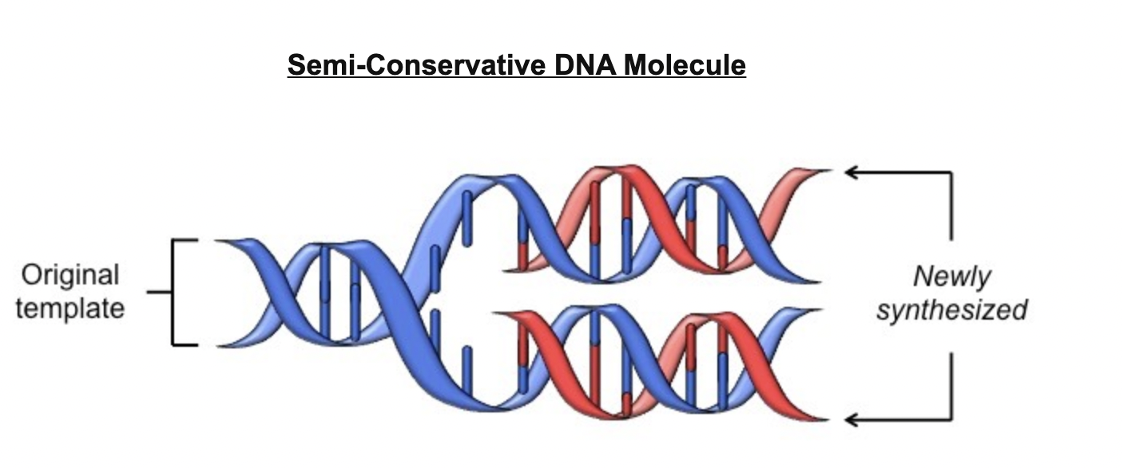
DNA REPLICATION
→ semi-conservative process because when a new double-stranded molecule is formed, one strand will be from the original template molecule, one strand will be newly synthesised
→ bc each nitrogenous base can only pair with its complimentary base (A+T/C+G)
→ each new strand formed will be identical to the original strand separated from the template
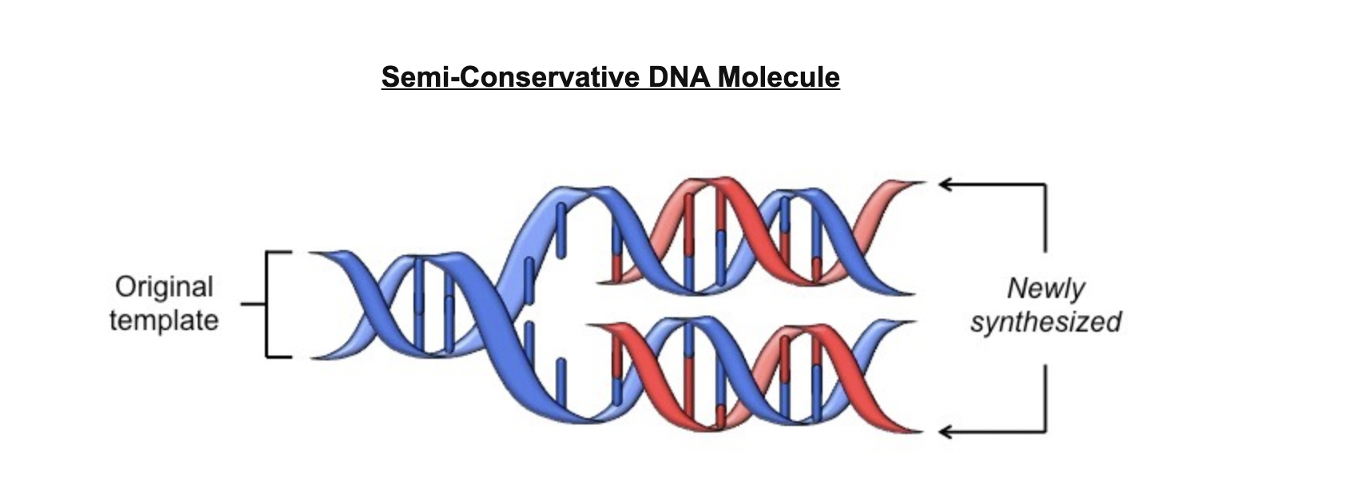
* female/male sex cells
* gametic
* humans have 23
* blood/skin/muscle cells
* somatic
* humans have 46
What type of cell are sex cells/what do they become
male sex cell ( 23 haploid) + female sex cell ( 23 haploid) fertilise and fuse = zygote (diploid)
info on chromosomes
XX = female (afab)
XY = male (amab)
typically 1 are the shortest and 22 longest
double of 21 or 13 is usually Down syndrome
GENOME
Refers to all the genetic material in one haploid set of chromosomes, contains all the necessary information for an organism to function + reproduce throughout its lifespan. Every cell in an individual has a complete set of the genome.
nucleus containing DNA → cell w/ copies of inherited DNA → organism w/ traits inherited from both parents.
GENE
Short sections of DNA that code for proteins.
Proteins provide many essential functions in the body (‘building blocks of life’), ie antibodies that support immune functions + other essential molecules of the body, support muscle contraction + movements etc.
* basically shares same gene, are same size
* Chromosome 2: both carry the same genes, ie. how your chin forms. each parent has different version of this- dad may have narrow chin and mother may have square chin, these are the variations of gene- the alleles.
* one allele will be dominant. locus for eye colour gene, mums blue dads brown, one dominant.
DNA
the molecule of heredity (the genetic transmission of characteristics from one generation to another)
ouble-stranded helix, the 2 strands are held together by hydrogen bonds.
Comes together, combines + twists up (SA)
There are no same pairings (i.e. 2 gs)
• Prokaryotic cells (simple cell lacks a nucleus and membrane-bound organelles) = DNA is located in the chromosome within the nucleoid and plasmids.
• Eukaryotic cells = DNA is located in the nucleus packaged into chromosomes.
Describe the structure of DNA ladder
2 antiparallel DNA strands
held together by hydrogen bonds
2 sugar phosphate backbones
double helix
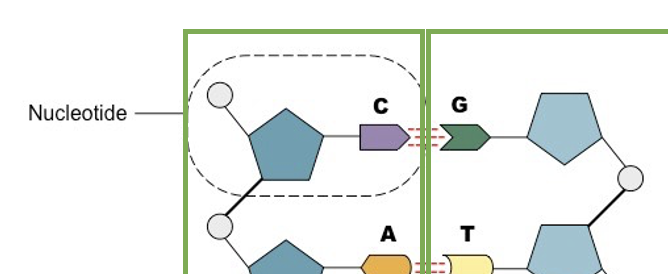
* Pentose sugar
* Nitrogenus base
* GUANINE
* CYTOSINE
* ADENINE
* THYMINE
PURINES | PYRIMIDINES
Guanine + Cytosine (3 BONDS)
Adenine + Thymine (2 BONDS)
GCTAAGTTCACTTG
n = number of sets, haploid = n, diploid = 2n
Monoploidy
Common in insects
→ (Different to haploid as) all cells having 1n, not just the sex cells
Polyploidy
• when an organism acquires 1 or more extra sets of chromosomes.
triploid (3N), tetraploid (4N)
→ common in flowering plants
14% Cytosine
Fertilisation
When the nucleus of a sperm fuses with that an egg nucleus, the diploid number of chromosomes is restored.
•Male and female haploid (1n) sex cells fuse to form a diploid (2n) zygote.
•The new individual will have a different combination of DNA from that of either parent.
•This ensures variation among offspring and between offspring and parents.

* they are 2n (diploid), they undergo meiosis 1 + 2 to create gametes (n) (haploid) (not mitosis)
* there are 2 cell divisions in meiosis, produces 4 daughter cells.
* Germ cells are found in the gonads
* Cell cycle still the same - G1, S, G2
M1: PROPHASE 1
**by the end of interphase, the chromosomes have sister chromatids (appearing double stranded)
Chromosomes condense, becoming visible
Chromosomes align with homolungus pair + synapse
Synapse = 1/more exchanges/crossovers occur between a matching segment of 1 chromosome with its pair, produces new combinations of genetic instructions, the sister chromatids are no longer identical.
nuclear membrane disappears

* chromosomes are NOT in single file (as mitosis), in pairs down the middle (metaphase plate)
* pairs are not mum/dad either side.
M1: ANAPHASE 1
chromosomes are pulled by spindles to opposite poles of the cell (not sister chromotids)
M1: TELOPHASE 1 + CYTOKENISIS
nuclear membrane forms around each group of separated single stranded chromosomes
chromosomes decondense
cell divides into 2 daughter cells
each of these 2 cells now undergo meiosis 2
* nuclear membrane disappears
* no crossing over/synapses occurs/no pairing of homologous pairs
* chromosomes decondense
* cell divides into 2 daughter cells
* Some non coding regions have specialised functions such as starting DNA replication or packaging the DNA into a chromosome or helping chromosomes align during mitosis.
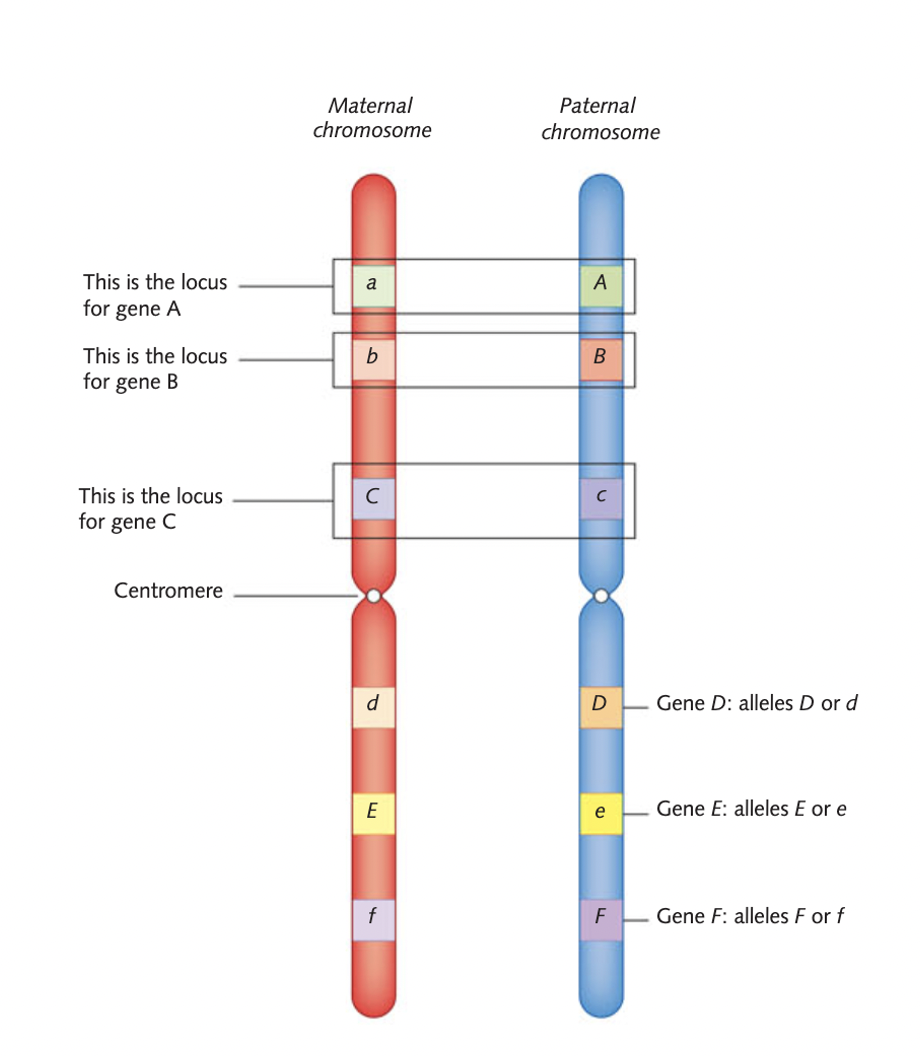
* maternal chromosome, paternal chromosome
* alleles
human autosomes - how many?
The 46 chromosomes of a typical human cell consist of 22 pairs of autosomes (numbered 1 to 22) and one pair of sex chromosomes (XX or XY)
* X contains about 900 genes
* Y contains about 55 genes
Karyotype
Visual display of an individual’s chromosomes set out in homologous pairs- which are arranged in order of length, usually from longest to shorter. Matched chromosomes by size, position of centromere and banding pattern to form pairs.
Provides info - sex, any extra/less chromosomes and therefore a genetic condition/disorder.
Humans - each H.P of autosomes given number from 1 to 22 and the sex chromosomes follow.
**write chromosomes as 46, 46 + x or 46 - x.
XX
female, one x from mother one from father
causes infertility
due to fusion of a Y sperm with a XX egg or XY sperm with an X egg
* banding pattern
* centromere location
Dark bands on chromosomes
A karyotype analysis usually involves blocking cells in mitosis (METAPHASE/PROPHASE so chromosomes are condensed visible) and staining the condensed chromosomes with Giemsa dye. The dye stains regions of chromosomes that are rich in the base pairs Adenine (A) and Thymine (T) producing a dark band.
How might non disjunction occur
• Failure of homologues to separate in Anaphase I (resulting in four affected daughter cells) MEISOS 1
n+ 1, n + 1, n - 1, n - 1
• Failure of sister chromatids to separate in Anaphase II (resulting in only two daughter cells being affected) MEIOSIS 2
n + 1, n - 1, n, n
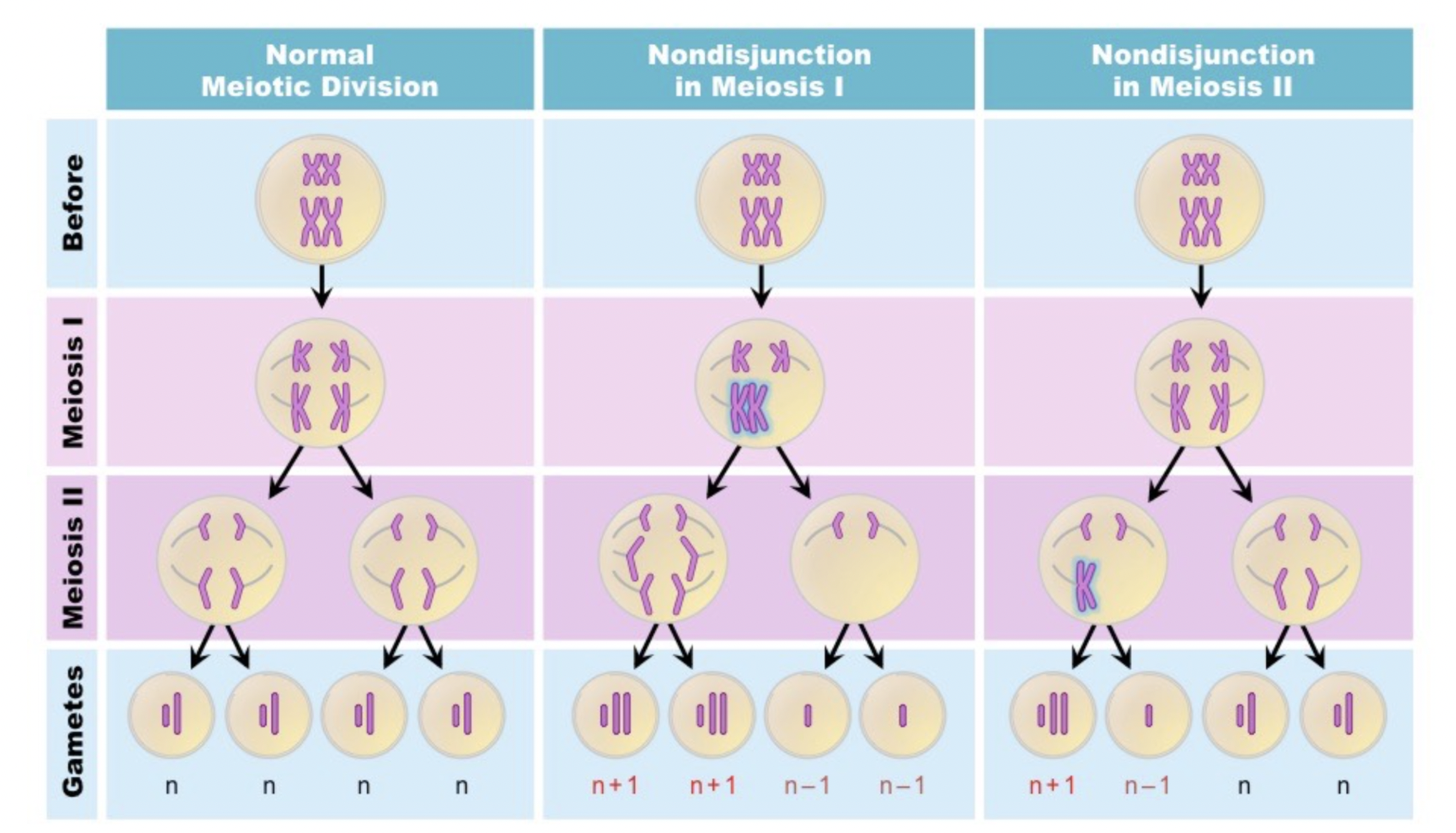
male can’t survive with just Y
X0/Y0
chapter 6.3
has letter key (A or a)
**Alleles are dominant or recessive,** you inherit 2 alleles for each gene.
Particular combination of alleles (eg. gene controlling for hairline) -
•__Hetero__zygous – Ww (1 dominant, 1 recessive allele)
•__Homo__zygous **dominant** – WW (2 dominant alleles)
•__Homo__zygous **recessive** – ww (2 recessive alleles)
i.e. the traits or characteristics that result from the genotype
\*\*if one/both are capitale then the trait will be shown -> capital 1st, e.g. Tt or TT then trait will be there, only not at tt. Allele from each parent, kid tt then parents both Tt (they both have trait)
e.g. hairline shape
(1 dominant, 1 recessive allele)
Ww
WW
ww
also: siamese cat owners have found that dark areas enlarge in winter and reduce in summer.
• Plants may only develop flower buds when night length and temperature is a suitable duration.
• Hours of darkness triggers flower production
Chemical modification of DNA
Chemical modification of DNA can also influence the phenotypic expression of genes.
Scientists found a pattern shown by altered DNA, where a methyl group or “chemical cap” was attached to part of the molecule.
This DNA methylation switched off the expression of the genes containing the modified DNA, so the trait wasn’t expressed.
Another type of structural DNA modification is caused by histone modification in the DNA molecule.
These changes normally occur during the individual’s lifetime but may also be transmitted to offspring.
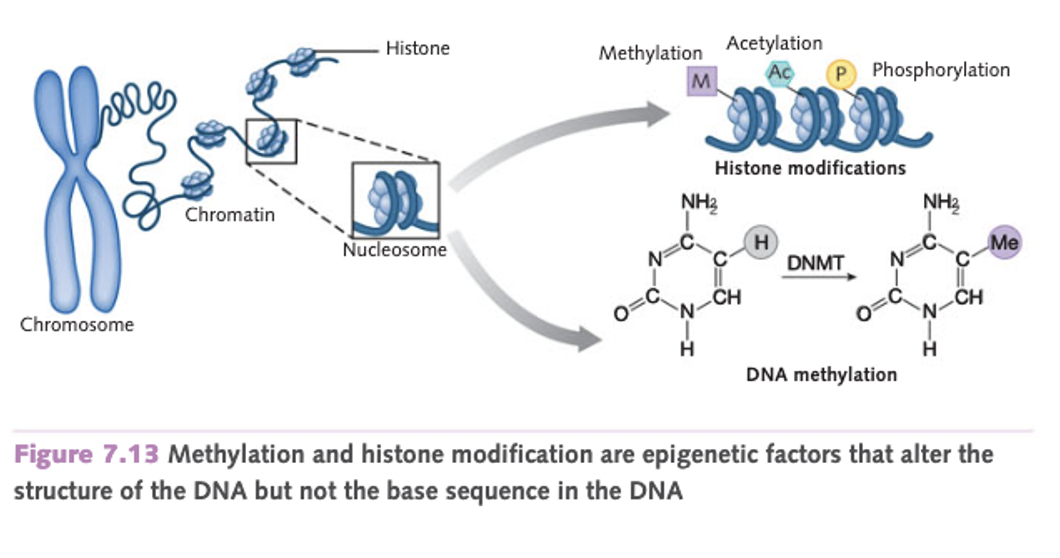
* Several environmental lifestyle factors including diet, obesity, tobacco smoke, alcohol consumption and enviro pollutants can modify epigenetic patterns.
* Current research investigates the role of epigenetics in various cancers, mental retardation and syndromes which involve chromosomal abnormalities.
* \
cancer and epigenetics
Cancer has been linked to epigenetics, diseased tissue from colorectal cancer patients was found to have less DNA methylation compared to normal tissue.
Genes which are methylated are generally switched off and not expressed, therefore loss of DNA methylation can cause higher gene activation.
Too much methylation could undo the work of tumour suppressor genes, allowing cancer to occur.
Fragile X syndrome is an inherited intellectual disability, usually in males – promoter region of FMR1 gene is methylated, turning off the gene which produces an important protein.
Coffin-Lowry and Rett syndromes.
1. Gg Gg Gg Gg
2. GG Gg Gg gg - genotype 1:2:1/25%-50%-25%, phenotype 3:1
e.g. blood types - AB, AO, BO, OO, BB, AA (6 types)
Incomplete dominance
•Sometimes the dominant gene doesn’t always mask the recessive gene
•This results in a mixed form
•This is called incomplete dominance
You can see it when you cross two pure-bredparents
As neither allele is dominant, the letter C represents the gene (colour) and the subscript (R and W) represent the alleles (red and white).
SW 177
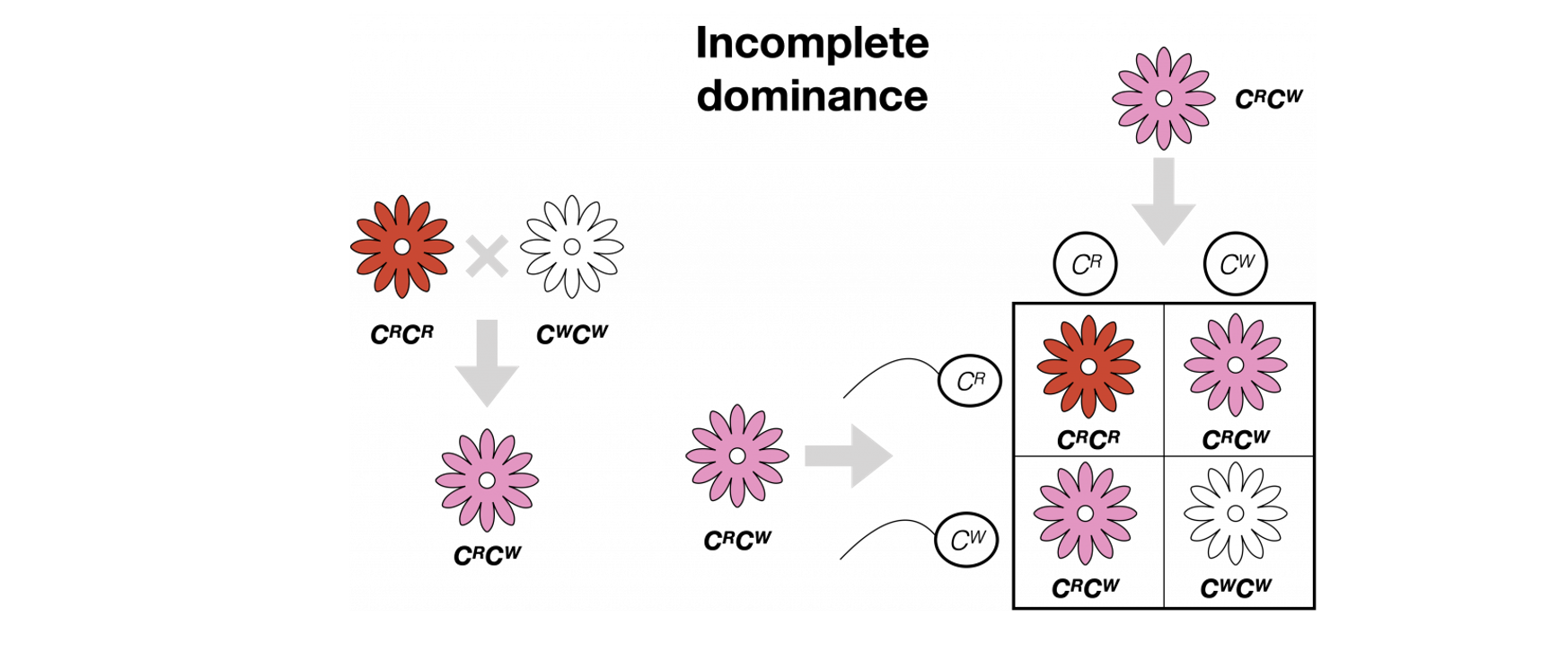
SW 178
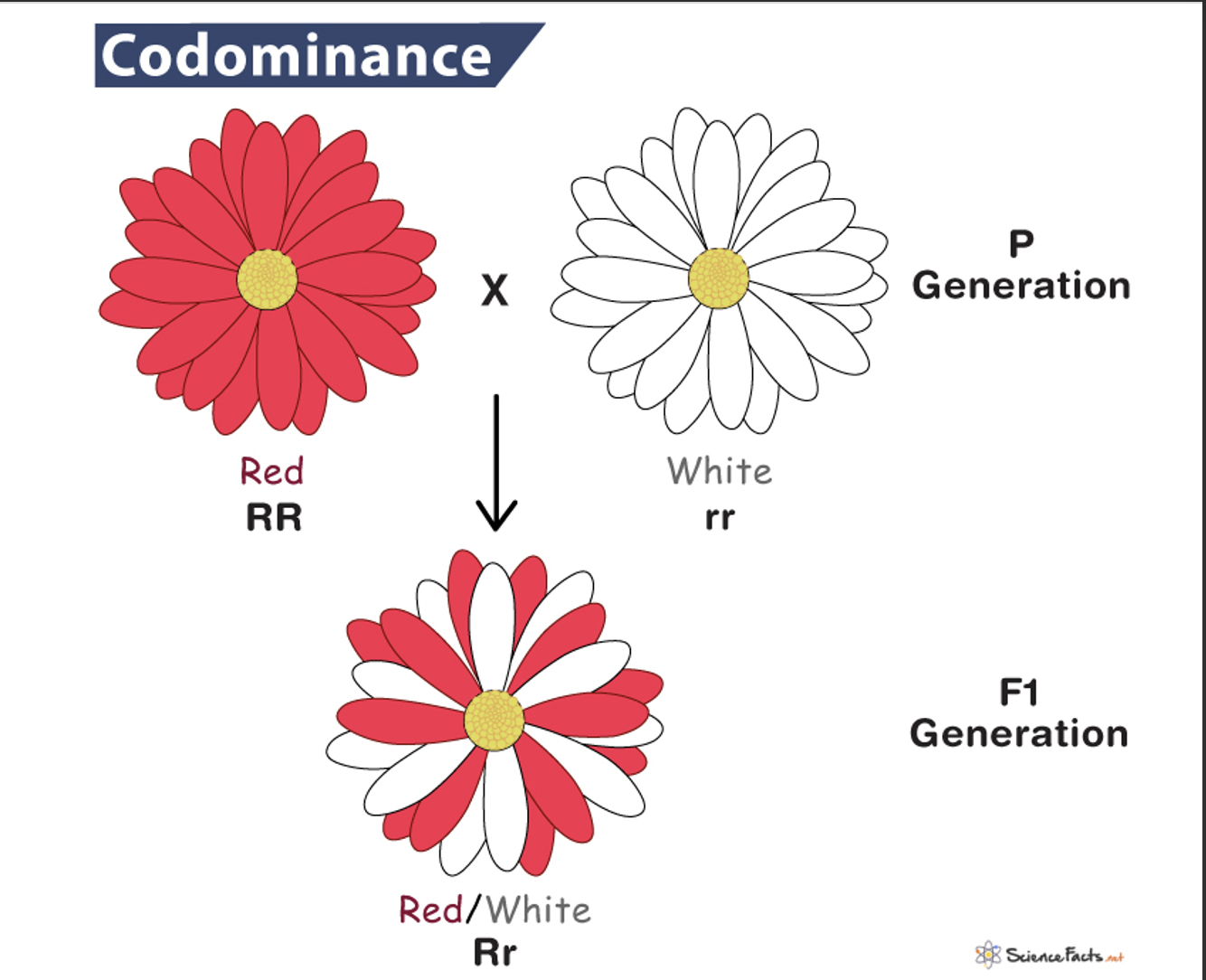
similarities and differences between incomplete dominance and codominance
Incomplete dominance
-Mix of both alleles
-Red x white = pink
-Codominance
-Expresses both alleles
-Red x white = red/white spots/stripes
-Both use superscript (extra letter)
-gene: C
-Red colour: C^r white colour = C^w
-Heterozygous = C^rC^w
-C^rC^r= pure red, C^wC^w= pure white
is masked by the dominant trait in heterozygous